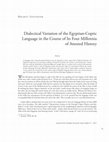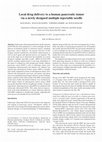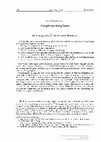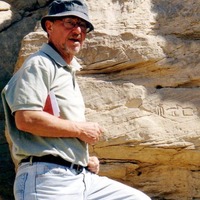Papers by Helmut Satzinger
Lingua Aegyptia 32, 2024
founded by friedrich Junge, frank Kammerzell & antonio Loprieno e d i to r S Heike Behlmer (götti... more founded by friedrich Junge, frank Kammerzell & antonio Loprieno e d i to r S Heike Behlmer (göttingen) frank Kammerzell (Berlin) antonio Loprieno (Basel) gerald Moers (Wien) M a n a g i n g e d i to r r e V i e W e d i to r S Kai Widmaier (Hamburg) eliese-Sophia Lincke (Berlin) daniel a. Werning (Berlin) a d V i S o ry B o a r d James p. allen, providence Christopher J. eyre, Liverpool eitan grossman,
Chronique d’Égypte 99, 2024
Urkunden der 18. Dynastie
Journal of the American Research Center in Egypt, 1988
The Demotic Verbal System
Journal of the American Research Center in Egypt, 1978
On Egyptian Participles and Nomina Agentis
Folia Orientalia, 2012
On Egyptian Participles and Nomina Agentis
Folia Orientalia, 2012
«Emphase» oder die Rhematisierung eines adverbialen Komplements im Ägyptischen (Rezensiosartikel)
Old Nubian — Black African language of the most ancient attestation
After 1900, the Aswân Dam was built; the farmers of Lower Nubia lost their fields and therefore t... more After 1900, the Aswân Dam was built; the farmers of Lower Nubia lost their fields and therefore their economic basis. Many migrated to the towns in the north, in particular to Cairo. In the early 1960s the High Dam was erected south of Aswân, Lake Nasser (in Nubia: “Lake Nubia”) began to flood anything that remained from the Nubian lands in Egypt as well as in Northern Sudan. The Nubians had to settle elsewhere: the Egyptians mostly near Kôm Ombo, north of Aswân; the Sudanese (the "Halfâwis", from the district of Wâdi Halfa) near Khash el-Girba on the ‘Atbara River, near the Ethiopian border.

Journal of the Canadian Society for Coptic Studies, May 5, 2017
A language with a long documented history may be expected to show a great deal of dialectal diver... more A language with a long documented history may be expected to show a great deal of dialectal diversity. For Egyptian-Coptic there are particular conditions. Except for the Delta, the country is one-dimensional, a feature that may make the distribution of dialectal differences simpler than in a country with a normal areal extension. Another specific feature is that all Egyptian idioms that precede Coptic are transmitted without the vowels, thereby obscuring all vocalic differences (which play such a great role in Coptic dialect variation). However, recent research has revealed that in the earliest stages of Egyptian language history there was a drastic dialectal gap. The feature best visible is the phonetic value and the etymology of graphemes ˁayin and ȝ. W hen Herodotus said that Egypt is a gift of the Nile, he was speaking of Lower Egypt, of the Delta: this whole area, with a north-south extension of ca. 170 km (in a beeline) and an east-west extension of ca. 260 km, owes its existence to all the soil that the river Nile has brought down from the Sudan in the course of a long time-span. However, most people think that he wanted to say that Egypt (as we intend it), from the Tropic of Cancer to the coast of the Mediterranean Sea, would not exist without the waters of the Nile, as there would be nothing but desert. Egypt is bipartite: on the one hand, a small country like others, of triangular shape; on the other, the two long and narrow shores of a river that crosses an endless desert. Whereas the Delta is twodimensional, like any other country, the Valley is one-dimensional, a narrow strip. The one-dimensional nature of the Valley has consequences for the question of dialects. It is to be assumed that the language of this area is in gradual dialectal transition from one end to the other. This is usually not so in a two-dimensional area. Coptic dialect variation does not seem to be very conspicuous in view of a language history of some 4000 years, in its last phase. The table entitled "Characteristic Lexemes in the Principal Coptic Dialects and Subdialects" in the Coptic Encyclopedia gives a good impression of the morphological, phonetic and lexicographic differences. 1 Many of these are in a linear order (north-south), others deviate from it in a certain measure. The reflex of the short Egyptian stress-bearing vowels, *á and *ɛ́ (the latter a merger of *í and *ú) is in an interesting 1 Kasser, 1991b: 88-96.
Unsere Kenntnisse auf dem Gebiet des Neuägyptischen sind wesentlich bestimmt von der von Černý ei... more Unsere Kenntnisse auf dem Gebiet des Neuägyptischen sind wesentlich bestimmt von der von Černý eingeleiteten Renaissance der neuägyptischen Studien, die sich in den späten 1960er und den 1970er Jahren vollzog. Von dieser Warte aus nimmt sich die frühe Ermansche OEuvre ein wenig urzeitlich aus. Die ägyptische Morphologie liegt inzwischen ziemlich geschlossen in klaren Paradigmen vor. Die heutigen
The Middle Kingdom hnmsw (Taf. 34)
Studien zur Altägyptischen Kultur, 2012
Corpus Antiquitatum Aegyptiacarum. Kunsthistorisches Museum, Wien. Ägyptisch-Orientalische Sammlung. Fasc. 4. Stelen des mittleren Reiches I. Einschliesslich der I. und II. Zwischenzeit
Journal of the American Research Center in Egypt, 1991

Journal of Egyptian Archaeology, Aug 1, 1973
Endoscopic ultrasound-guided fine needle injection (EUS-FNI) has been proposed as a novel techniq... more Endoscopic ultrasound-guided fine needle injection (EUS-FNI) has been proposed as a novel technique for local delivery of antitumor agents to refractory tumors, including pancreatic cancer. However, the present outcome of this strategy remains insufficient, and further improvements as well as novel agents and injection devices are required. The aim of the study was to determine the feasibility of a newly designed ̔multiple injectable needle̓ (MIN) for EUS-FNI and the resulting improvements in the drug distribution to the tumor in comparison with straight-type needles. Human pancreatic cancer BxPC-3 cells or orthotopic tumor were transplanted subcutaneously into athymic rats. Ethanol was injected into subcutaneous tumors using a MIN or straighttype needle. Sequential sections of subcutaneous tumors were stained with hematoxylin and eosin, and tumors and injury areas were quantified using ImageJ software. In the orthotopic tumors, injection of the outer needle of the MIN, advancement of the inner needle and ethanol infusion were monitored by EUS. Injury volume of subcutaneous tumors using a MIN was greater than that with the straight-type needles, except for large tumors. Injecting process using MIN was monitored with endoscopic ultrasound (EUS). This study showed improvement in the drug distribution in a tumor, following injection with MIN compared to straight-type needles, suggesting the novel device to be feasible for use in EUS-FNI.
Neuägyptische Studien: Die Partikel 'ir. Das Tempus-System
Journal of the American Oriental Society, 1979
1) ir-constructions: topicalisation, conditional clauses, temporal clauses. 2) The tense system o... more 1) ir-constructions: topicalisation, conditional clauses, temporal clauses. 2) The tense system of Late Egyptian. The "narrative." The clause of circumstance. Etc.
Die negativen Konstruktionen im Alt- und Mittelagyptischen
Journal of Egyptian Archaeology, Aug 1, 1970
Journal of the American Research Center in Egypt, 1975
Eine entsprechende Untersuchung fur die mittelag. Negationen nj und nn hat schon B. Gunn, Studies... more Eine entsprechende Untersuchung fur die mittelag. Negationen nj und nn hat schon B. Gunn, Studies in Egyptian Syntax. Paris 1924, vorgelegt. 3) U. a. A. H. Gardiner u. B. Gunn und zuletzt noch mit neuen Argu menten B. Kroeber, Die Neudgyptizismen vor der Amarnazeit. Diss. Tubingen 1970, S. 63 ff. (mit Literaturverweisen). 4) bw ausschlieBlich als Satznegation vor finiten nicht-emphatischen Verbal formen (sdm-f einschl. rbwpw-f sdm < bw p>-f sdm, sdm.n-f, sdm.t-f, sdmw-f Passiv); bn als Satznegation in Nominal-, Adjektiv-und Adverbialsatzen (einschl. der Satze mit einer emphatischen Verbalform als Subjekt), von Exi stenzsatzen mit determiniertem Subjekt, vor futur. sdm-f (und vielleicht sdmw-f-V&ssiv) sowie als Wortnegation.
Zeitschrift Fur Agyptische Sprache Und Altertumskunde, Dec 1, 1986
Urkunden der Blemmyer
Chronique d'Egypte, 1968
EGYPTE GRECO-ROMAINE Urkunden der Blemmyer Aus einer recht unklaren Quelle (*) ist in den Achtzig... more EGYPTE GRECO-ROMAINE Urkunden der Blemmyer Aus einer recht unklaren Quelle (*) ist in den Achtzigerjahren des vorigen Jahrhunderts eine Reihe von Urkunden blem-myischer Herkunft auf uns gekommen. Drei davon befinden sich in Kairo : Krall (2) I. II. III, in griechischer ...

Zeitschrift Fur Agyptische Sprache Und Altertumskunde, Feb 1, 1997
Im folgenden sollen mehrere Formeln, die ausdrücken, daß die Gottheit dem König Leben gibt, gemei... more Im folgenden sollen mehrere Formeln, die ausdrücken, daß die Gottheit dem König Leben gibt, gemeinsam analysiert werden: 1. Die typische Gottesrede an den König, dj-n-j' n-k r nh usw. 2. Der Zusatz dj-f r nh usw. zu Gottesnamen 3. Der Zusatz dj r nh zum Namen des regierenden Königs 4. Der Ausdruck jr-k r nh-tj am Ende mancher Gottesrede bzw. der Ausdruck jr-f(n-f) r nh am Ende von Überschriften (Beischriften) zu Opferhandlungen u. dgl. 2 5. Der Ausdruck jr-f dj r nh am Ende von Überschriften (Beischriften) zu Opferhandlungen u. dgl. bzw. der Ausdruck jr f(n-f) dj r nh am Ende der Weihformel 3 Die Phrasen haben unter anderem gemein, daß parallel zu r nh noch Wörter wie ddt, wis, snb, >wt jb stehen können (allerdings nicht in allen Fällen in substantivischer Form). Diese Substantive können mit nb "alles" erweitert sein. Ferner kann mj R r dt "wie Re ewiglich" (oder nur mj R c oder nur dt) angefügt sein. Grundsätzlich ist klar, daß der Geber des Lebens die Gottheit ist und der Empfänger der regierende König. Dies kommt mitunter in der Genus-und Numeruskongruenz zum Ausdruck. Bei den Pronomina der 2. und 3. Person ist das Genus unterschieden, bei allen Pronomina der Numerus 4. Dies betrifft prinzipiell die Gottheiten). Der regierende König ist hingegen nach dem Dogma erstens nur einer und zweitens männlich. Zu letzterem gibt es eine berühmte Ausnahme. Hatschepsut machte sich in vollem Umfang zum Pharao; dabei behielt sie in den traditionellen Phrasen teilweise das maskuline Genus, in anderen Fällen ließ sie feminin formulieren. Aus diesem Grund sind die Inschriften dieser Herrscherin wichtig für die Beurteilung der Struktur der angeführten Phrasen 1. 1 Die in der neueren deutschen Ägyptologie beliebte Lesung (r)dj statt (r)dj beruht auf Edel, Altäg. Gramm. § 459, wo Doublettenschreibungen mit für aufgezeigt werden. Es handelt sich um zwei Personennamen auf Denkmälern der 6. Dynastie sowie eine Sargtext-Variante (Birsha 2, Bologna). Das sind Perioden, für die der partielle Ubergang von der palatalen zur nichtpalatalen Artikulation des d bereits in Betracht kommt; sie sind methodisch wertlos.-Korrektursatz: Nach einer neuerlichen Untersuchung der Inschrift der Frauenstatue Turin Kat.-Nr. 3065 aus der 3.










Uploads
Papers by Helmut Satzinger